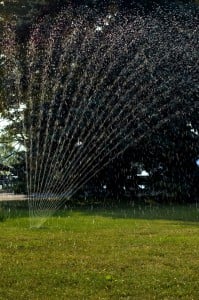We all know that grass needs to drink, but how and when should you water it? There are good ways and not so good ways to water your lawn.
How Much to Water
While not enough water will leave your lawn dying, too much can make it sick. Most lawns require one inch of water a week. Break that up into two ½ inch watering sessions. To calculate, mark an inch on a few plastic containers, place them around the watering zone, and time how long it takes them to fill to an inch. That’s how long you should water your lawn.
At the same time, make sure the water is penetrating deep into the roots. If the water is only skimming the surface, you’ll end up with weeds.
- Dig a hole and measure how far the roots go down. Most grass roots are 8”-12”; Bluegrass is 6”-8”.
- Turn on the sprinkler for 15 minutes.
- Wait 24 hours and dig a hole in the watered grass.
- Measure how deep the water seeped in 15 minutes. Then use your multiplication skills to calculate how long you should leave the sprinklers on for the water to penetrate to the bottom of the roots.
When to Water

Water only when the grass needs it. Don’t overdo it. Overwatering creates conditions that lead to fungus and disease. Not all grasses and climates are created equal either. Things that affect watering frequency are temperature, humidity, and wind. The easiest way to tell is to simply look at the grass. These three things will tell you it’s time to water:
- The grass has a blue-gray tint.
- Leaf blades are starting to curl at the top or wilting.
- Footprints are staying in the grass longer instead of bouncing back.
Run the sprinklers early in the morning, and typically no later than 9:00 a.m. This prevents most water from evaporating because of heat or being blown away by wind.
Watch the weather. If rain is forecasted within the next day, hold off watering. Let the rain do it for you. If your soil is too dry it won’t be able to absorb the rain as well. In this case, run your sprinklers for about 15 minutes - just enough to moisten the soil.
What to Avoid
Make sure the sprinklers are aimed at the lawn and nothing else. Sounds obvious, but how many times have you seen sprinklers shooting into a sidewalk or driveway?
Runoff is also a waste. Some soils absorb water slower. A thick layer of thatch can also cause slower absorption. If you notice that water is running into the street before the lawn is completely watered, turn off the sprinklers and let the grass sit for about 20 minutes. Once the water has soaked in, turn the sprinklers back on and finish.
If your lawn suffers from a few brown spots, don’t run the sprinklers on the entire lawn. You may end up overwatering it. Instead, use a watering can or hose to cover problem areas by hand.
For help getting your yard in tip-top shape or just maintaining its manicured look, contact a TaskEasy certified contractor for a free quote!





Let Us Know What You Thought about this Post.
Leave a comment below.